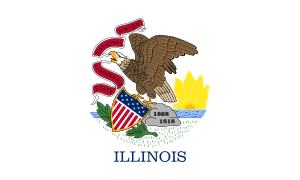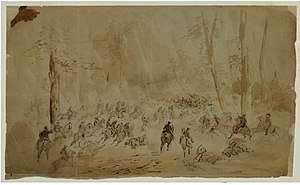92nd Illinois Volunteer Mounted Infantry Regiment
The 92nd Regiment Illinois Volunteer Mounted Infantry was a mounted infantry regiment that served in the Union Army during the American Civil War.
| 92nd Regiment Illinois Volunteer Mounted Infantry | |
|---|---|
 Illinois state flag | |
| Active | 22 July 1863 to 10 July 1865 |
| Country | United States |
| Allegiance | Union |
| Branch | Mounted Infantry |
| Equipment | Spencer carbine |
| Engagements | American Civil War
|

Service
The 92nd Regiment Infantry Illinois Volunteers was organized at Rockford, Illinois, and mustered into the United States service 4 September 1862. It was composed of five companies from Ogle County, three from Stephenson County, and two from Carroll County. The regiment left Rockford, 11 October 1862, with orders to report to Gen. Wright, at Cincinnati, where it was assigned to Gen. Baird's Division. Army of Kentucky.[1]
It marched immediately into the interior of the State, and during the latter part of October was stationed at Mt. Sterling, to guard that place against rebel raids, and afterward at Danville, Kentucky. On 26 January 1863, the regiment, with Gen. Baird's Division, was ordered to the Army of the Cumberland. Arriving at Nashville, the command moved to Franklin, Tennessee, and was engaged in the pursuit of the rebel Gen. Van Dorn. Advanced to Murfreesboro, and occupied Shelbyville, 27 June. On 5 July, the regiment was engaged in rebuilding a wagon-bridge over Duck River.
The 92nd Illinois Infantry converted to mounted infantry on 22 July 1863 and rearmed with Spencer carbines. It then served as a part of Brigadier General John T. Wilder's Lightning Brigade, where it remained while Gen. Rosecrans had command. The regiment crossed the mountains at Dechard, Tennessee, and took part in the movements opposite and above Chattanooga, when it recrossed the mountains and joined Gen. Thomas at Trenton, Alabama. On the morning of 9 September, it was in the advance to Chattanooga, and participated in driving the rebels from Point Lookout, and entered the rebel stronghold, unfolding the Union banner on the Crutchfield House, and kept in pursuit of the rebels.
At Ringgold, Georgia, it was attacked by a brigade of cavalry, under command of Gen. Forrest, and drove them from the town, killing and wounding a large number. During the Chickamauga battle, the regiment took part in Gen. Reynolds' Division of Gen. Thomas' Corps. In April, 1864, it was again at Ringgold, Georgia, doing picket duty. April 23, Capt. Scovil, with twenty-one men, was captured at Nickajack Gap, nine miles from Ringgold, and one man killed. Of the men thus taken prisoners, twelve were shot down, and six died of wounds, after being taken prisoners. The remainder were taken to Andersonville; and very few ever left that place, having died from the cruel treatment received there.
From Ringgold, May 7, 1864, the regiment entered upon the Atlanta campaign and was assigned to Gen. Kilpatrick's command, and participated in the battles of Resaca, raid around Atlanta, Bethesda, Fleet River Bridge, and Jonesboro. The regiment lost, at Jonesboro, one-fifth of the men engaged. From Mount Gilead Church, west of Atlanta, October 1, the regiment moved, and took an active part in the operations against Hood's army. At Powder Springs it had a severe engagement, losing a large number of men, killed and wounded. The regiment then returned to Marietta, and participated in the various engagements and skirmishes in Sherman's march to the sea. At Swift Creek, North Carolina, Capt. Hawk, of Co. C, was severely wounded, losing a leg.
The regiment, during its term of service, was in some forty battles and skirmishes. The regiment was mustered out at Concord, North Carolina, on June 21, 1865, and discharged at Chicago, on July 10, 1865. The regiment's recruits were transferred to the 65th Illinois Volunteer Infantry Regiment on that date.
Total strength and casualties
The regiment suffered casualties of 1 officer and 51 enlisted men who were killed in action or who died of their wounds, and 2 officers and 127 enlisted men who died of disease, for a total of 181 fatalities.[2][3]
Commanders
- Colonel Smith D. Atkins - Mustered out with the regiment.[4]
See also
- List of Illinois Civil War Units
- Illinois in the American Civil War
References
- History of Stephenson County, Illinois, by W. H. Tilden. Chicago: Western Historical Society, 1880.
- The Civil War Archive website after Dyer, Frederick Henry. A Compendium of the War of the Rebellion, 3 vols. New York: Thomas Yoseloff, 1959.
- The Civil War Archive
- Illinois in the Civil War website after Illinois Adjutant General's muster rolls
Further reading
- History of Stephenson County, Illinois, by W. H. Tilden. Chicago: Western Historical Society, 1880, pp. 885-886.